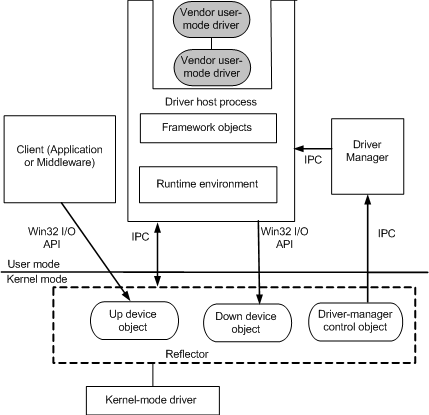Note
Access to this page requires authorization. You can try signing in or changing directories.
Access to this page requires authorization. You can try changing directories.
This topic describes how the driver manager builds a user-mode device stack, and how the host process, reflector, and driver manager process an I/O request that an application sends to a User-Mode Driver Framework (UMDF) driver.
Similar to a kernel-mode stack, the construction and tear down of a user-mode stack is driven by Plug and Play (PnP) events. After the kernel-mode stack has been built, the reflector notifies the driver manager to start construction of the user-mode stack. The driver manager launches the driver host process and provides sufficient information to the launched process to build the user-mode stack. In this way, the user-mode stack can be considered an extension of the kernel-mode stack.
The driver host process provides the execution environment for user-mode drivers and routes messages between drivers in the user-mode stack. The reflector uses a message-based interprocess communication mechanism to communicate with the driver manager and host process.

To send an I/O request to a UMDF driver, an application calls a Win32 file I/O function, such as CreateFile, ReadFileEx, CancelIoEx, or DeviceIoControl. When the reflector receives a request from the client application, it sends the request to the appropriate driver host process. The driver host process then routes the request to the top of the correct user-mode device stack.
The request is either completed by one of the drivers in the user-mode stack or forwarded by one of the drivers back to the reflector. When the reflector receives a request from the user-mode driver stack, it sends the request down the kernel-mode stack for completion.